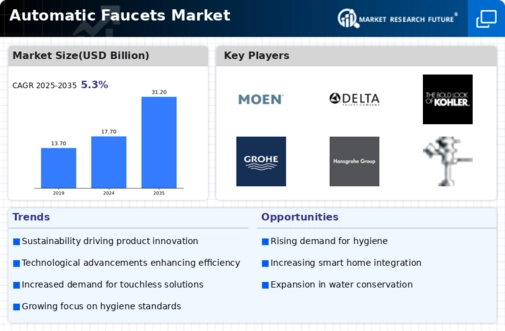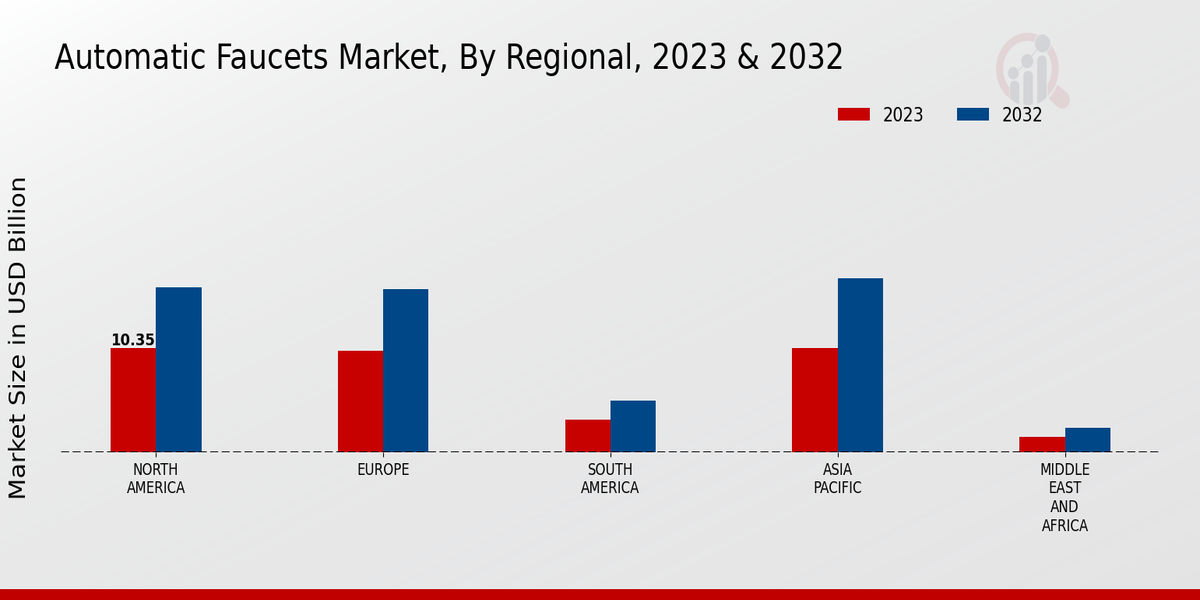Market Growth Projections
The Global Automatic Faucets Market Industry is projected to experience robust growth over the next decade. With an estimated market value of 17.7 USD Billion in 2024, the industry is expected to reach approximately 31.2 USD Billion by 2035. This growth trajectory indicates a compound annual growth rate of 5.26% from 2025 to 2035. Factors contributing to this expansion include increasing hygiene awareness, technological advancements, and supportive government regulations. As the market evolves, it is likely to attract new entrants and innovations, further enhancing its competitive landscape.
Growing Demand for Hygiene Solutions
The increasing global emphasis on hygiene and sanitation is a primary driver for the Global Automatic Faucets Market Industry. Consumers and businesses alike are prioritizing touchless solutions to minimize the spread of germs and bacteria. This trend is particularly evident in public restrooms, healthcare facilities, and food service establishments, where the risk of contamination is heightened. As a result, automatic faucets are becoming a preferred choice, leading to a projected market value of 17.7 USD Billion in 2024. This growing demand for hygiene-focused products is likely to sustain the market's expansion in the coming years.
Increased Awareness of Water Conservation
There is a rising awareness of water conservation among consumers and businesses, which is positively impacting the Global Automatic Faucets Market Industry. With growing concerns about water scarcity and environmental sustainability, many individuals are seeking ways to reduce their water consumption. Automatic faucets, known for their efficiency in minimizing water waste, are becoming increasingly popular. This shift in consumer behavior is likely to drive demand for these products, as more people recognize the benefits of touchless technology. As a result, the market is expected to expand significantly in the coming years.
Technological Advancements in Sensor Technology
Innovations in sensor technology are significantly influencing the Global Automatic Faucets Market Industry. Enhanced infrared and ultrasonic sensors are now more accurate and responsive, improving user experience and operational efficiency. These advancements not only reduce water wastage but also increase the longevity of the faucets. Manufacturers are increasingly integrating smart technology, allowing for remote monitoring and control. This technological evolution is expected to contribute to the market's growth, as consumers seek modern, efficient solutions. The integration of these technologies may also lead to a compound annual growth rate of 5.26% from 2025 to 2035.
Rising Urbanization and Infrastructure Development
The rapid pace of urbanization and infrastructure development across the globe is a significant factor propelling the Global Automatic Faucets Market Industry. As cities expand, there is a growing need for modern plumbing solutions in residential and commercial buildings. Automatic faucets are increasingly being installed in new constructions and renovations, driven by the demand for convenience and efficiency. This trend is particularly pronounced in developing regions, where urban infrastructure is evolving rapidly. The anticipated growth in urban populations is expected to boost the market, potentially reaching a value of 31.2 USD Billion by 2035.
Government Regulations and Sustainability Initiatives
Government regulations promoting water conservation and sustainability are driving the Global Automatic Faucets Market Industry. Many countries are implementing stricter standards for water usage in commercial and residential buildings. Automatic faucets, which typically use less water than traditional models, align well with these regulations. For instance, initiatives aimed at reducing water waste in urban areas are encouraging the adoption of touchless faucets in public facilities. As a result, the market is likely to see increased investments and innovations that comply with these sustainability goals, further enhancing its growth trajectory.










